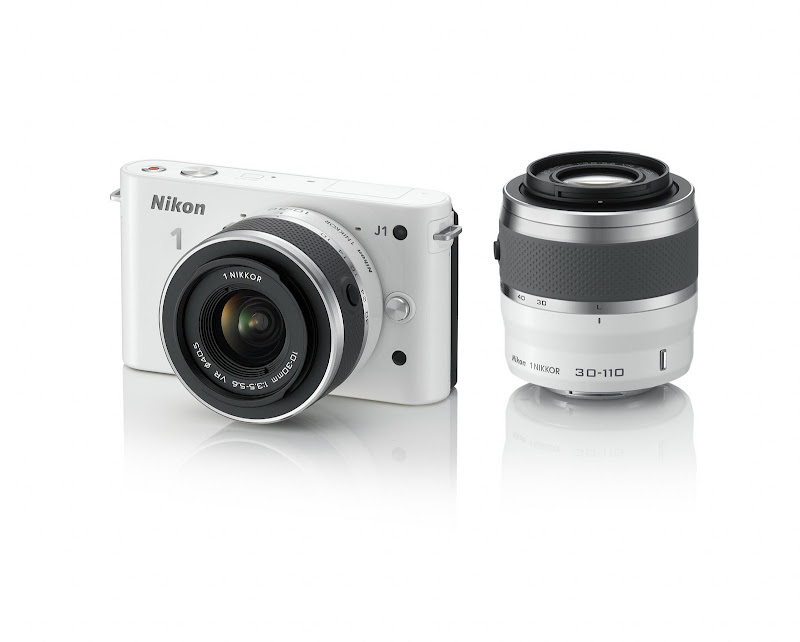If you like this post, help us share it
Nikon announces their entry to the mirrorless market with the Nikon 1 system J1 and V1. Apparently, Nikon stated that the new interchangeable lens system is their most significant announcement since Nikon first introduced digital camera 14 years ago! You have to applaud the effort Nikon put in to design a completely new system introducing two new cameras and four lenses at launch. The J1 and V1 are equipped with a 2.7x crop factor CMOS sensor which Nikon calls it CX format and is made by Nikon in house. 
 The CX sensor measures 13.2 mm × 8.8 mm which is smaller than the sensor used in m4/3s and Sony NEXs. There are a lot of disappointing fans out there with regards to Nikon’s new CX format, most hoping for a larger sensor size. Sony has equipped their NEXs with a large APS sensor in a small body which is what everyone wanted and hence why the NEXs are selling like hot cakes. Unfortunately for many enthusiast photographers, Nikon has made a decision to use a much smaller CX format sensor, in view of targeting compact camera users and not to jeopardise their DX DSLR line up such as the D3100 and D5000.
The CX sensor measures 13.2 mm × 8.8 mm which is smaller than the sensor used in m4/3s and Sony NEXs. There are a lot of disappointing fans out there with regards to Nikon’s new CX format, most hoping for a larger sensor size. Sony has equipped their NEXs with a large APS sensor in a small body which is what everyone wanted and hence why the NEXs are selling like hot cakes. Unfortunately for many enthusiast photographers, Nikon has made a decision to use a much smaller CX format sensor, in view of targeting compact camera users and not to jeopardise their DX DSLR line up such as the D3100 and D5000.
Sensor Size comparison between Sony NEX and Nikon 1 J1
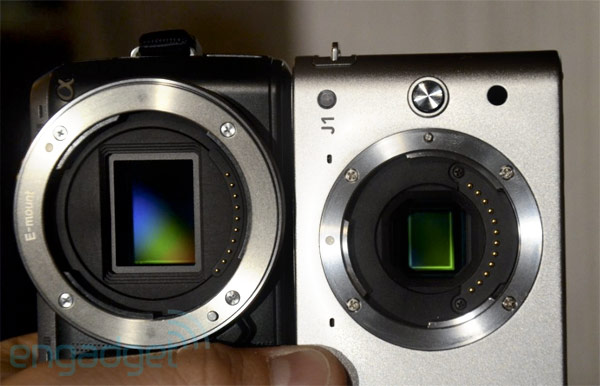

The new J1 and V1 are most certainly not designed as a second camera for SLR users, but rather as an upgrade path for compact users when they outgrow their compacts and want to explore the SLR world.
Here is a size comparison between the Nikon 1 J1 and Olympus PEN. source ephotozine.com


 The Nikon 1 system has ditched the traditional PSAM mode on the dial, but instead replaced with 4 different application modes.
The Nikon 1 system has ditched the traditional PSAM mode on the dial, but instead replaced with 4 different application modes.
1. Still image mode which you can still select PSAM modes in the menu
2. Movie mode
3. Motion snapshot which combines still images with movie recording
4. Smart photo selector which takes 20 photos and then pick the best 5 photos for you.
The two cameras initially launched are very similar in size, and share the same CX sensor and many key features. Both cameras can shoot at 10 frames per second and are supported by an all-new image processor EXPEED 3. This allows the camera to achieve a remarkable data processing speed. Nikon claims that the Nikon 1 system cameras outpace the D3S by a considerable margin.
Another brilliance of the J1 and V1 is their ‘Hybrid’ autofocus system that employs both Phase and Contrast Detection focus methods (135 points with contrast-detection AF and 73 with phase-detection AF) to track and capture fast-moving subjects in sharp, crystal-clear focus. Nikon stated that the Nikon 1 system is equipped with the fastest autofocus of all the cameras up to date, including the D3s.
The phase detection AF is not only for still images, but also used in video mode, so you can track and focus on moving subject much better during video shooting.
What are the differences between the J1 and V1?
-
J1 is available in various colours and is similar in size, as well as equipped with a built in pop up flash.
-
V1 is equipped with an EVF and accessory port to connect an external flash, GPS and potentially other accessories.
-
The LCD resolution for V1 is higher at 921k dots vs 460k dots on J1
-
Aluminium alloy body for J1 and Magnesium alloy body for V1

-
V1 is equipped with a mechanical and electronic shutter, whereas J1 is only with an electronic shutter, so the flash sync is faster on the V1.

Nikon J1 Electronic Shutter

Nikon V1 Mechanical Shutter
Nikon has put a lot of effort in making the Nikon 1 simpler and faster, especially in the AF area where we can expect see a noticeable difference. This also shows a glimpse on what we can expect to incorporate into the next generation of DSLR, D4 and D800.
With m4/3 sensor and Sony’s NEX APS sensor, you can expect a much better image quality and ISO performance compared to compact cameras. The ISO performance from m4/3 and Sony NEX is considered to be close to what entry level DX DSLR is offering. See test samples here and here. From experience, I would say m4/3s and NEXs are useable up to ISO 800, anything more will be noisy. Given that Nikon is the master of making cameras with superior ISO performance, it is probably accurate to assume that even with the smaller CX format sensor, the ISO performance could still matches the m4/3s.
So what’s missing? AF is fast and brilliant; the IQ could be on par with m4/3…
What you could not achieve with the Nikon 1 is the shallow Depth of Field that you see in DSLR. Even with DX DSLR, the 1.5x crop factor had a major impact on the DoF, now with the 2.7x crop factor CX sensor, the DoF is even wider.
If we compare the DoF between CX, m4/3, DX and FX formats at 35mm, f/2.8 with a subject distance of 4m, the DoF on Nikon 1 J1/V1 is significantly wider than on the Nikon D7000, even a huge difference compared to the Olympus E-P3.
|
Camera |
Focal Length |
35mm Focal Length |
Aperture |
Subject Distance |
DoF |
|
Nikon J1/V1 |
13mm |
35mm |
f/2.8 |
4m |
12.7m |
|
Olympus E-P3 |
17.5mm |
35mm |
f/2.8 |
4m |
6.48m |
|
Nikon D7000 |
23.3mm |
35mm |
f/2.8 |
4m |
3.95m |
|
Nikon D3s |
35mm |
35mm |
f/2.8 |
4m |
2.38m |
More photos from ephotozine.com
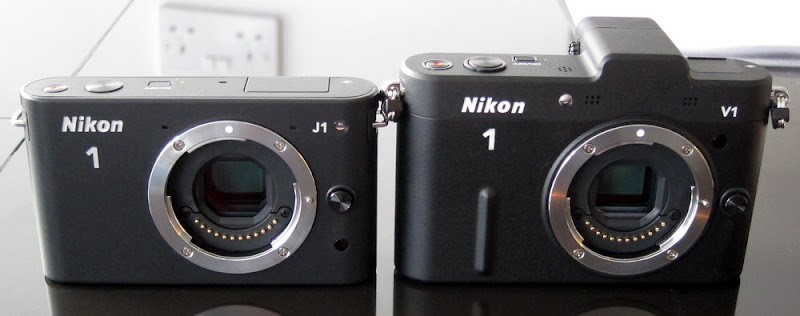
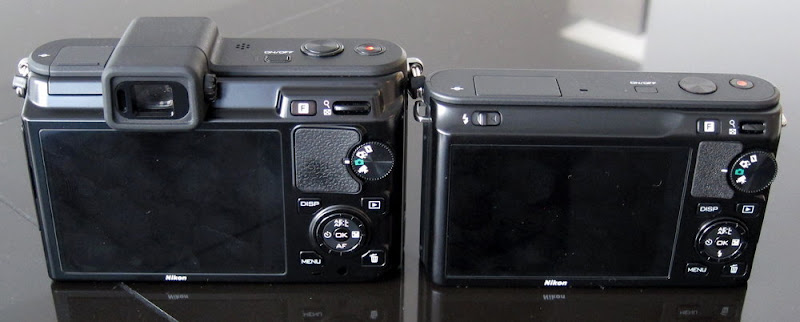
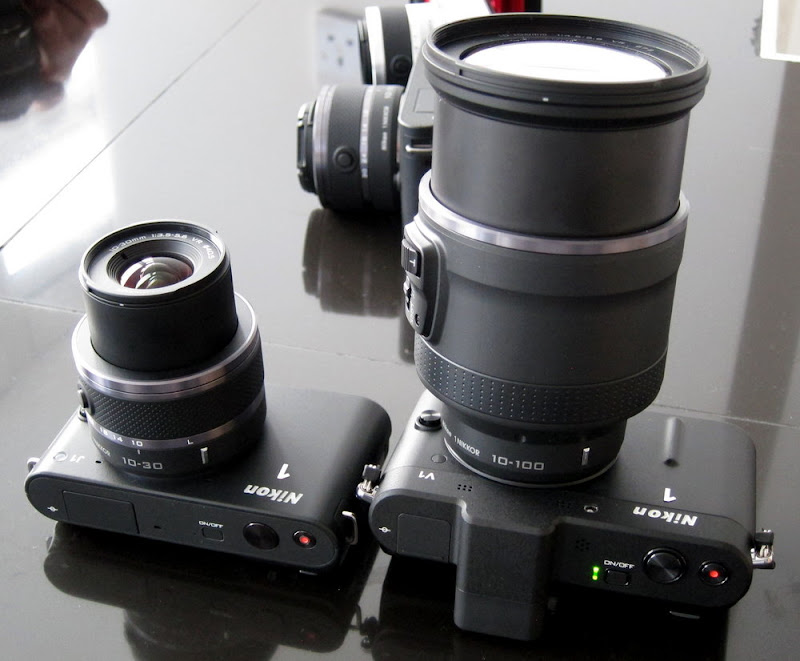
Where can I find the equipment seen on this site?
If you find this site useful and planning to purchase any of the equipment seen on this site, please show your support by purchasing your photo equipment at B&H Photo Video, or through any of the affiliate links seen on this site.

